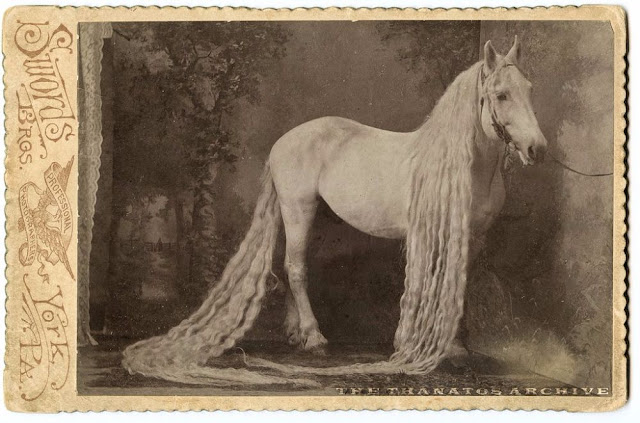Throughout human history long hair has been a desirable and much sort after quality. Most people cannot grow their longer than their lower backs, but there are a few individuals who can grow their hair to the floor. Until quite recently such individuals could make a quite successful living on the circus and side show circuit displaying their exceptionally long hair. The reason why humans are able grow such long scalp hair is open to question. There doesn’t seem to be any obvious biological advantage to growing hair so long. While it may be important to grow some hair on the scalp to protect the head from sunlight and to keep the brain warm, growing hair beyond shoulder length doesn’t seem to be particularly useful. It might be that long hair was used as an indicator of health when it came to finding a mate, but more usually, hair coat quality and luster is important in attracting a mate, not so much the length of the hair. Studies on lions and their manes have confirmed this. Females look for healthy manes on males, but mane length is not important. Perhaps as humans have/had no real predators we have/had the “luxury” to produce long hair even though it confers no significant biological advantage.
Long hair isn’t just seen in humans. Long hair can be found in a number of animals, but usually these animals are domesticated and specially bred to produce long hair either for esthetic appeal or for commercial use. For example, merino sheep are bred to produce a long (and fine) wool coat. If it is not shorn regularly the coat builds into an excessive covering. The sheep can end up looking like puff balls on legs if neglected. But in the wild, a truly long hair coat can be a disadvantage. The hair can cover the eyes and reduce sight. It can overheat the animal in a hot weather zone. It can be heavy enough to slow the animal down and reduce their chances of escape from their natural predators. Indeed, long hair can make it easier for predators to grab hold and pull down their long haired prey. In the “wild” long hair is the almost exclusive domain of humans – but not quite.
This is a legend of wild horses in Oregon with exceptionally long manes and tails. Eventually, some of these horses were captured and bred as circus horses. The wild population died out long ago and the captive bred horse lineage also seems to be been lost. Back in the 1880s though, these horses were a popular side show and circus attraction that made a lot of money for their owners. The most famous of the long haired horses was “Linus” (actually there were two linuses). A leaflet from the Nineteenth century tells the story here.
(via keratin.com)
Long hair isn’t just seen in humans. Long hair can be found in a number of animals, but usually these animals are domesticated and specially bred to produce long hair either for esthetic appeal or for commercial use. For example, merino sheep are bred to produce a long (and fine) wool coat. If it is not shorn regularly the coat builds into an excessive covering. The sheep can end up looking like puff balls on legs if neglected. But in the wild, a truly long hair coat can be a disadvantage. The hair can cover the eyes and reduce sight. It can overheat the animal in a hot weather zone. It can be heavy enough to slow the animal down and reduce their chances of escape from their natural predators. Indeed, long hair can make it easier for predators to grab hold and pull down their long haired prey. In the “wild” long hair is the almost exclusive domain of humans – but not quite.
This is a legend of wild horses in Oregon with exceptionally long manes and tails. Eventually, some of these horses were captured and bred as circus horses. The wild population died out long ago and the captive bred horse lineage also seems to be been lost. Back in the 1880s though, these horses were a popular side show and circus attraction that made a lot of money for their owners. The most famous of the long haired horses was “Linus” (actually there were two linuses). A leaflet from the Nineteenth century tells the story here.
(via keratin.com)


















.jpg)






0 comments:
Post a Comment